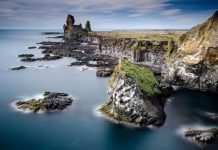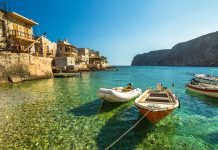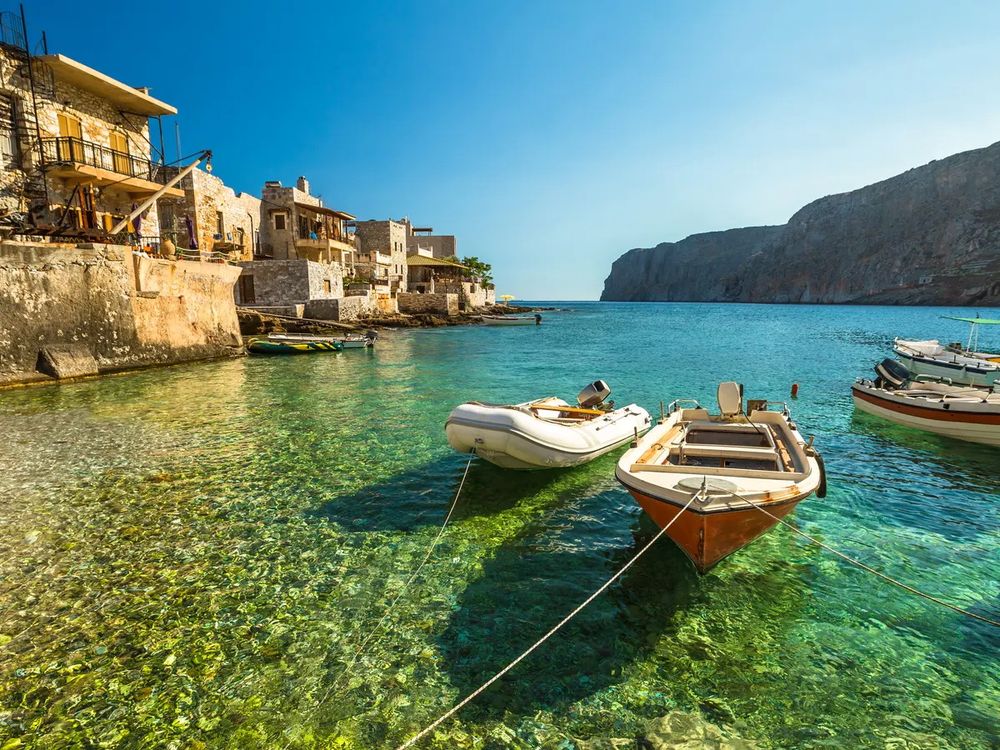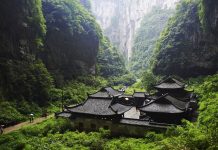Gastouri: Gastouri is the picturesque village, chosen by Princess Sissy, the Empress of Austria, to find peace after her son’s death, by building here the famous “Achillion”. The village is built on the slope of Aghii Deka mount and lots of people had their rural houses and stone villas, even before Achillion is built. Here, you have to admire the unique view from Bella Vista and Belvedere, as well as to buy fresh bread by Ektor’s traditional bakery.
Kanoni: Kanoni is the most photographed place in the island. It is located 4km far from Corfu (Kerkyra) town, in a beautiful green region, with dreamed beaches. From here, you will enjoy the best view in the island, to Panaghia Vlaherna and the famous Pontikonissi.
It is named after the cannon, stood here by the French, in 1798, that it is still here. At the cosmopolitan region of Kanoni, there are some of the biggest hotels and many restaurants and night clubs. Kanoni is approached south of Corfu (Kerkyra) town via the village Analipsis; it’s well signed, but it is needed to ascend most of the way.
Kynopiastes: Kynopiastes is a traditional village of central Corfu (Kerkyra), only 10km far from Corfu (Kerkyra) town. Here, you will find old mansions of the 17th, 18th and 19th century, a marble church, a monastery of the 17th century and the unique in the island, olive tree museum.
At Kynopiastes, there are some of the most famous taverns in Corfu (Kerkyra), with traditional Corfiot dishes. Among them, there is the famous, worldwide, tavern “Trypas”, where Kings, like the Kings of Greece and England, Presidents of Countries, like Konstantinos Karamanlis (Greece) and Francois Mitterand (France), stars of the European and American cinema and music, like Jane Fonda, Anthony Quinn etc. have been hosted.
It is on the way leading to the tourist resorts of Aghios Gordios and near the tourist resorts Glyfada, Ermones, Benitses and to the villages Kato Garouna, Sinarades.
Lazareto island: Lazareto island is located at the northeastern side of Corfu (Kerkyra) town, 2 nautical miles far from it. It is a green island of 70.000 sq.m. with historic importance. Its official name is Aghios DImitrios, but the name Lazzaretto is owed to its use as a leper-house (leprosarium) during the Venetian rule (early 16th century), like Nazaretum (paraphrasing it to Lazareto) island in Venice, Italy, used for the same purpose. The name Lazareto is given to all the leper-houses, set up by the Venetians in Europe (there is also a Lazareto island in Ithaca and in Zante).
Pontikonissi: Pontikonissi means “Mouse Island”. It is a small, uninhabited island, used in order to house a monastery. It is a very green place with abundant trees, located at the entrance of Halikiopoulos lagoon, opposite to Corfu (Kerkyra)’s airport “Ioannis Kapodistrias”. It is one of the most famous and most popular tourist sights of Corfu (Kerkyra). During the last years, many improvements have been made here, like the construction of the pier, in order to reach the boats that connect it with Kanoni and Perama, safely, during summer. Pontikonissi is a natural museum and it is not permitted to visit it, unless you will come instantly under the supervision of the guards. The only day that you can come to the island is on 6 August, the day that the chapel here, devoted to the Transfiguration of Christ, is honored. It is the white stone staircase of the monastery that when viewed from afar gives the impression of a (mouse) tail.
Vidos island: Vidos is a small island (less than kilometre in diameter), situated opposite of Corfu (Kerkyra) port, 1200m. far from the old port. It is Corfiots’ favorite place to relax, during summer, since it has beautiful nature and crystal waters, in a very small distance from Corfu (Kerkyra) town. It is connected with the port of Corfu (Kerkyra), with regular boats (every thirty minutes in the summer).
It is named after one of its owners, Guido Malipieri, whose name “Guido” was changed to Vido. In 1985 the island comes to the hands of the municipality, which protects its natural beauty. In the north of the island, there are buildings restored, which are used as public camping. Here, you will find restaurants, cafes, organized beach, as well as beautiful paths, ideal for trekking in spring.
Settlements and Destinations in north Corfu (Kerkyra)
Doukades: The traditional and well-preserved settlement of Doukades is located on the eastern part of Istoni mountain, next to the street from Corfu (Kerkyra) to Paleokastritsa and 20km far from Corfu (Kerkyra) town. It is a village at least four hundred years old (first mentioned in a notary act of 1616), which is named, according to some researchers, after its first inhabitants, who had the surname “Doukas”.
Here, you should eat at the small taverns, at the central square, as well as visit the renovated stone mansion of Theotokis family, the Koraggios mansion, the Venetian “sagrado” of Quartanos and the beautiful building of the historic Elementary School, at the entrance of the village. Don’t forget to follow the street, at the entrance of the village, to the hill of Aghia Anna, to admire the amazing Mediterranean landscape.
Episkepsi: Episkepsi is one of the larger settlements on the slopes of mount Pantokratoras. Here, you will see grandiose mansions and traditional houses, beautiful traditional coffee shops and small stone paths, inside a mountainous landscape through rich olive groves.
At Carnival, several customs take place here, the most important of which is the Byzantine custom of the Priests’ Dance.
Kato Korakiana/Katomeri: Kato Korakiana or Katomeri is located at the northeastern part of Corfu (Kerkyra), at the foot of mount Pantokrator, about 10km far from Corfu (Kerkyra) town. It is one of the biggest villages in Corfu (Kerkyra), with a history of more than five centuries long. It is the lowest settlement of the village of Korakiana, compared to Ano Korakiana, which is the upper village.
Besides the constant raids because of its position near the sea and especially near the bay of Ipsos, the whole region suffered geological phenomena which resulted in important land slidings in the recent history. A geological phenomenon is also a tunnel (Grava tou Menigou), about which the local people will tell you that, according to experiments carried out a little before World War II (1938), it leads to an underground river which flows under the sea and into the coasts of Ambrakikos Bay, near Preveza (Epirus).
Here, you have to walk through the old mansions and visit the medieval castle of the Polylas family, the current “Villa Mibelli”, a unique building inside a forest of spruces, pine trees and other perennial trees. A little outside the village, you can visit the old knight’s medieval tower of Garoufas, where Dionyssios Solomos, the national poet of Greece, used to come, to relax and write, as well as the “tsou giatrones” (which means “belonging to the doctors”), the villa of the Italian doctors hidden in thick vegetation (19th century). Also, you can enjoy the local taverns and coffee shops, you can watch a cultural event if you are lucky, or visit the nearby tourist resorts Dassia, Ipsos and Dafnila.
Antinioti Lagoon: Antinioti lagoon is located at the northern coasts of Corfu (Kerkyra) and it is considered an especially important wetland for the environmental balance of the wider region, a nature reserve protected by the Natura 2000 convention, a network of nature conservation sites throughout the European Union. The lagoon is abundant with reeds, aquatic plants and wild flowers (16 varieties of wild orchid) and it is also the habitat of many fish, ducks, swans, herons, hawks and many other species such as the protected species lutra-lutra.
The protection and sustainable management of the region are expected to contribute not only to the protection of wildlife, but also to the economic development of the region (fishing, amusement, ecotourism).
Nymphes: Nymphes is a big village in north Corfu (Kerkyra), full of green and waters. It is named after the Nymphs, who used, according to a legend, in old times, to bathe in the village’s waterfalls. Nymphes valley is the place where kum-quat, the traditional product of Corfu (Kerkyra), is growing. Here, you can visit the premises of the Agriculture Co-operative, which elaborates kum-kuat and produces liquor and sweets.
A little outside the village, you can visit Askitario, a small historic monastery, where lived in the 5th century the monk Artemios Paissios from Epirus, who is said to have worked many wonders.
Settlements and Destinations in south Corfu (Kerkyra)
Alyki in Lefkimi: Until 1988, the region around this wetland was a salt marsh (produced salt). Since the salt works closed, the region has revealed a wonderful natural environment, with interesting species of flora and several types of vegetation. At the same time, there have been interventions for the development of the buildings and the premises and the long sandy beaches are accessible to everyone.
Korission Lagoon: This region is at the southwestern shores of Corfu (Kerkyra), 4km at the eastern of Argyrades village. It is the main wetland in the island, a composite and well-preserved ecosystem of a high aesthetic, biological and economic value and includes Korission lake (the argest of Corfu (Kerkyra)), the coastal area of the lake, as well as seashore regions, characterized by various types of Mediterranean vegetation. It is an important region for the protection of wildlife, particularly for the protection of the avifauna, as well as for the preservation of the spontaneous vegetation of the region. The most important place in the region is considered to be a narrow strip of land which separates the Korission Lake from the sea. On the sandy beaches near the lagoon and, particularly at the southern part of the region, there is the unique for the region cedar woods as well as the rocky dunes, which create a unique landscape, with unprecedented looks. It is protected by the Natura 2000 convention, a network of nature conservation sites throughout the European Union.









